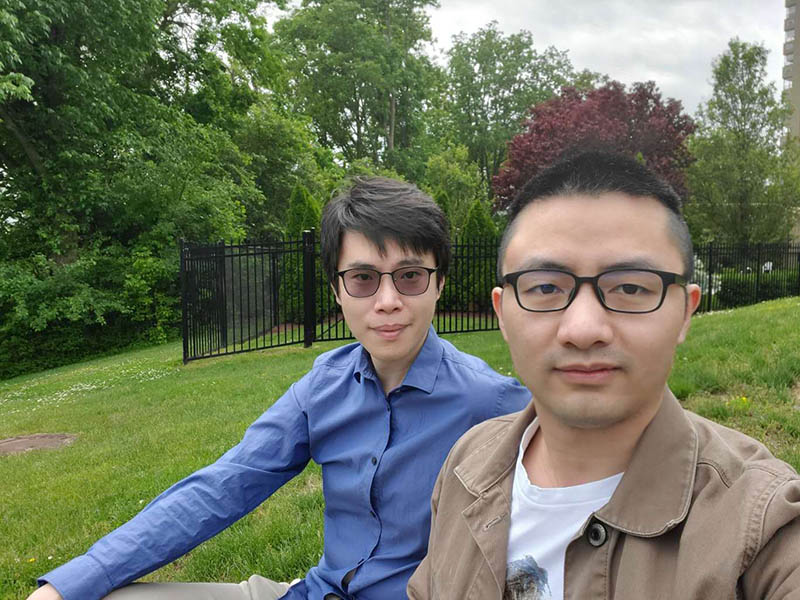Former Roommates “Cook” Nanomaterial Together

PhD students and former roommates Ji Lang and Dong Zhou
Nanotechnology has shown a great deal of promise, but there is still much to learn about the process of making nanomaterials (those containing features 1/1000th of the diameter of a human hair). This is true for the monolayer two-dimensional transition metal dichalcogenides (TMDs) composing only three layers of atoms. These new materials act as semiconductors, meaning their behavior can be useful in a variety of engineering electronics applications. Its commercialization, however, is hindered by the poor scalability of the synthesis process which is not yet understood.
Two Villanova PhD students and former roommates, Dong Zhou and Ji Lang, began an unusual conversation last spring, prompted by their dramatically different research fields. Zhou is working on nanomaterial assembly and synthesis under the guidance of Dr. Bo Li, assistant professor of Mechanical Engineering, and Lang is working on biofluid mechanics and brain concussion (making significant contribution to the “Smart Brain” project), with Dr. Qianhong Wu, associate professor of Mechanical Engineering. In this conversation, the two students discussed cooking nanomaterials—not food. At that time, Zhou was working on chemical vapor deposition (CVD) of MoSe2, a type of TMDs. In CVD, raw materials called precursors are mixed in a hot chamber where they react with each other on the surface of an object to form layers of molecules in a precise manner. Zhou discovered, however, that this cooking process was not easy. No matter how well he controlled the procedure and tailored the parameters, he was unable to achieve a large-scale film of MoSe2 as expected. “This is a black box,” he complained, to which Lang responded, “Maybe I can help.” With that a new research project was launched.
CVD is essentially a fluid-driven material deposition process, however, researchers working in nanomaterial synthesis have limited understanding of fluids, which determine the size and evenness of coverage of new layers of molecules on the surface. In this student-initiated collaboration, Lang helped perform fluid mechanics analysis and computational fluid dynamics (CFD) simulation to describe the transport of different materials in the “black box,” and Zhou was in charge of “cooking” to provide experimental verification and validation of the CFD simulation. As a result of their students’ efforts, Drs. Li and Wu decided to establish a new direction of fluid-guided CVD growth, in addition to their many ongoing collaborations. Eventually, with Lang’s help, Zhou redesigned his synthesis setup with better fluid control and achieved inch scale continuous film of MoSe2 and a new level of understanding of the critical roles of fluid flow in the synthesis of TMDs. This research has the potential to revolutionize the CVD process, leading to new strategies to design the CVD setup and achieve controllable nanomaterial synthesis.
Zhou and Lang have published their first paper as co-first authors in this new area titled “Fluid guided CVD growth for large-scale monolayer two-dimensional materials.” The article appears in ACS Applied Materials & Interfaces, DOI: 10.1021/acsami.0c04125. The paper’s coauthors are Nicholas Yoo, a rising Chemical Engineering senior at Villanova University who helped perform the Raman spectrum measurement, and Dr. Raymond Unocic from the Center for Nanophase Materials Sciences, Oak Ridge National Lab, who contributed the image of the MoSe2 using a scanning transmission electron microscope. Drs. Wu and Li led the project and are corresponding authors of this paper.
Zhou, Yoo and Dr. Li were partially supported in this research by the Villanova startup fund and the U.S. Department of Energy, Office of Science, Office of Workforce Development for Teachers and Scientists under the Visiting Faculty Program. A portion of this research was conducted at the Center for Nanophase Materials Sciences (CNMS2019-271), which is a DOE Office of Science User Facility. Lang and Dr. Wu were partially supported by the National Science Foundation CBET Fluid Dynamics Program under Award #1511096.
